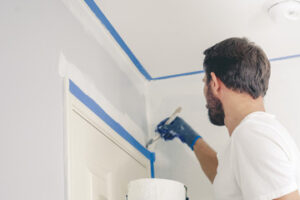House Painters Modesto CA have the expertise and experience to take the stress out of your home painting project. They prioritize open communication and abide by fair payment arrangements.

Avoid falling victim to a “bait-and-switch” strategy by identifying red flags such as a lack of transparent communication and a failure to sign a contract. This will protect your investment and empower you to make a well-informed decision.
When it comes to painting your home, choosing the right colors is a critical factor in creating an aesthetic that aligns with your vision and style. However, it can be difficult to make sure your color selections are successful without professional guidance. Fortunately, expert house painters offer color consultation services to help you achieve the perfect look for your home.
During the color consultation process, the paint consultant assesses your space and provides you with high-quality samples to try in your home. They take into account factors like lighting conditions, existing colors, and architectural styles to provide you with the best possible results. Moreover, they use advanced visualization tools to help you see how different colors will look in your space before making a commitment. This helps you avoid costly mistakes and ensures that your final result perfectly matches your vision.
In addition to color consultation, many painters also provide interior and exterior design services to help you make the most of your home’s potential. They can help you with things like arranging furniture, selecting window treatments, and choosing the best paint products to meet your needs. This can save you time and money by eliminating the need for multiple remodeling projects in the future.
Color has a powerful impact on your mood and perception of space, so it’s important to choose the right shades for your home. A color consultation service can help you avoid common mistakes and create a harmonious and inviting atmosphere in your living spaces. It can also make the entire renovation process much easier and more stress-free by ensuring that all the pieces fit together perfectly.
During the color consultation process, the paint contractor will ask you about your preferences and style. They will then suggest a variety of color options that match your personality and style. This will help you find the ideal colors for your walls, ceilings, and other surfaces. They will also discuss color flow, which is the way that your colors transition from one room to the next. This can be subtle and harmonious or stark and invigorating, depending on your personal preference.
Long-Lasting Results
The right materials and meticulous approach are the keys to a long-lasting paint job. Experienced house painters know how to prepare surfaces to ensure lasting results, including properly taping windows, sanding movable areas to promote adhesion, and addressing structural issues such as holes or cracks.
They also use premium, durable products that resist fading or peeling. When paired with professional application, these high-quality products ensure your home’s interior or exterior color retains its original beauty for years to come.
Local house painters have an in-depth understanding of your regional weather conditions and can recommend the best products for your unique needs. This helps to avoid the costly headaches caused by inferior products or improper techniques that can be common in DIY projects.
Reputable house painters prioritize open communication and are willing to discuss paint options with you. They understand that hiring a painting contractor is a significant investment and are committed to helping you find a solution that aligns with your preferences, budget, and property’s condition.
Beware the “Bait and Switch” Tactic
Dishonest house painters employ pressure tactics and limited-time offers to create urgency, encouraging you to make a decision on the spot. These strategies rely on your fear of missing out and desire for a great deal, but they can also lead to hasty decisions, buyer’s remorse, and unsatisfactory results.
Verify Licensing
A legitimate house painter will provide you with a written quote detailing the project scope, completion timeline, and labour and material costs. If a house painter fails to provide you with this information, request it before making a decision. In addition, be sure to verify their licensing and insurance status before hiring them to work on your home. Licensing demonstrates that they’ve met industry standards and are qualified to perform the work, while insurance protects you from liability in case of accidents or damages during the project.
Eliminate the Stress
A professional house painter is a skilled craftsman that can transform your home’s interior or exterior into a visual masterpiece. Their mastery of various painting techniques, up-to-date knowledge of materials, and awareness of environmental considerations guarantee a long-lasting finish that enhances the value and beauty of your home.
In addition to their skills with a brush, they are also knowledgeable about color psychology and lighting effects. This allows them to guide homeowners through the complexities of selecting colors that match their vision, while considering current trends. Color selection is a critical factor in creating living spaces that support mental and emotional well-being, with research showing that certain shades have specific soothing and calming qualities.
Reputable house painters prioritize open communication, providing detailed breakdowns of their services and a clear explanation of any repair recommendations. This approach prevents the pitfalls of the classic bait-and-switch tactic, in which scammers lure you in with high-quality materials and service before switching to less-than-ideal results.
Punctuality is another key trait of reputable house painters. They understand that your time is valuable, and they respect your commitments and deadlines. Their punctuality sets the tone for their relationship from the start, establishing trust and fostering a productive project.
A well-done paint job can elevate a home’s curb appeal, increase property values, and boost resale appeal. It can also reduce the frequency of maintenance and repairs, saving both time and money. A professional painter will use their expertise to refresh your home’s exterior without compromising its architectural integrity.
When selecting a house painter, look for one that prioritizes open communication, understands the importance of punctuality, and offers transparent payment terms. A written contract that outlines all services, costs, and expectations is essential to a stress-free project.
A professional house painter handles all aspects of the painting process, including preparation, surface cleaning, and clean-up, ensuring that you receive a smooth, polished result. They are fully equipped with their own equipment and know what supplies will produce the best results, so you don’t have to waste time wandering paint aisles at your local hardware store.
Transparent Payment
When choosing a house painter, look for one who offers transparent payment arrangements. Legitimate professionals are open to a deposit upfront for supplies and a final payment based on project milestones. They prioritize transparency in their payments to foster trust and maintain accountability throughout the project. Spotting shady payment practices can help you avoid being victimized by painting scams.
Professional house painters are dedicated to providing high-quality workmanship, which meets or exceeds industry standards. They use premium-quality paints and tools to achieve uniform coverage, smooth finishes, and precise detailing. They also have extensive experience working in the local area and are familiar with the climate, soil composition, and other environmental factors that can affect the lifespan of a painted surface.
Reputable house painters will be happy to provide references and proof of their licensing, certifications, workman’s compensation, and liability insurance. They will also be willing to answer any questions you may have about their services and offer a free estimate before starting the project. This helps you make a well-informed decision, making it easier to stick to your budget and get the job done right the first time.
A high-quality interior and exterior paint job can dramatically improve the overall appearance of your home. It can also increase your property’s value by enhancing curb appeal, adding a fresh layer of protection against the elements, and reducing the need for costly repairs in the future. Aside from the practical benefits, a professionally-painted home can also boost the overall ambiance of your living space and contribute to your mental wellness.
When choosing a house painter near you, look for one who offers free estimates. This enables you to shop around and choose the best contractor based on the quality of their workmanship, customer service, and other important factors. Additionally, reputable painting contractors will clearly list the costs of labor, materials, and other expenses in their quotations.
When shopping for a house painter, it’s important to check out their website and social media profiles. You should also ask for referrals and read online reviews to gain a comprehensive perspective of their capabilities and reputation. Be wary of house painters who employ high-pressure sales tactics and make hyperbolic promises.
